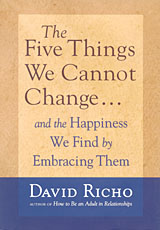Five Things We Cannot Change
 The Five Things We Cannot Change … And the Happiness We Find By Embracing Them
The Five Things We Cannot Change … And the Happiness We Find By Embracing Them
by David Richo
Review and comments by Terri Harmon, May 2006
I found many nuggets and insights in this book. The basis of the book is looking at what the author identifies as the five givens, and discussing ways to be with them in a way that releases the pain of struggling against them. I found some useful insights about feelings, such as jealousy, anger, and hate. And there was one passage on being with and responding to “Life is not always fair” that named and brought clarity to a process I had just been through. (“The middle path means a willingness to be open while also maintaining healthy boundaries. … We seek amends when others treat us unfairly, ask for redress, and if this doesn’t work, we let go.”)
I’ll share direct passages from the book regarding these 3 topics.
The Five Givens and how we can transform our struggle with them:
There are five unavoidable givens, five immutable facts that come visit all of us many times over: (p. xi)
1. Everything changes and ends.
2. Things do not always go according to plan.
3. Life is not always fair.
4. Pain is part of life.
5. People are not loving and loyal all the time.
Siddhartha Guatama (Buddha) – “His legendary transformation began by facing the laws of life with curiosity and courage.” – i.e. saying yes to what is.
Our fear in the face of the givens: (p. 103)
1. We may lose what we have.
2. Our expectations will not be met.
3. We might not get our fair share.
4. We will not be able to handle it.
5. We will feel hurt and have to grieve.
How we mask our fear:
1. Being less committed or becoming stoical.
2. Plan every detail and try to stay in control.
3. Insist on keeping everything even and blame those who are unfair.
4. Try to be on guard to avoid pain.
5. Stay away from closeness in the future.
Saying Yes to What is:
1. Grieve and let go.
2. Accept what happens and learn from it.
3. Have an attitude of “You win some; you lose some” while working for justice.
4. Allow pain that is natural and do not add to pain by attempting to control it.
5. Speak up and say “Ouch!” while not retaliating.
On Being with “Life is not always Fair” (direct quotes from book):
(p. 34) “The challenge is to meet our losses with loving-kindness, the commitment to act and think lovingly toward others, especially when they test our patience or act hurtfully toward us. Cultivating loving-kindness when people treat us unfairly or hurtfully helps us by keeping our hearts open in and through the moment of being hurt. Openness does not mean we let ourselves be victims of abuse. We simply allow ourselves to be what we are at our most loving, that is, vulnerable. Any human interaction or relationship can have painful moments in it. A mature adult notices that closing off is dangerous to her sensitivity and that remaining too open is dangerous to her boundaries. The middle path means a willingness to be open while also maintaining healthy boundaries. We commit ourselves to that form of yes by a practice: We seek amends when others treat us unfairly, ask for redress, and if this doesn’t work, we let go, and our hearts do not close. Letting go has the effect of opening the heart.”
On Feelings (direct quotes from book):
(p. 133) “We may also confuse feelings with states of mind like loneliness or jealousy. We do better to acknowledge the authentic feelings behind our inner states. Instead of “I feel lonely,” try “When I am lonely, I feel …” This may station us in one of more of the four basic feelings (SAFE – sad, angry, fear, exuberant) rather than make us head for foot, alcohol, drugs, sex, or shopping.
Jealousy is in fact not a feeling but a combination of three feelings: anger, fear, and sadness – with paranoid fantasies obsessively embroidering them. To identify our real feelings is a way of taking responsibility for our predicament rather than distracting ourselves with getting back at others or turning to addictions for comfort. …..
Hate can be confused with anger. Hate has five traits: strong anger, a malicious need to hurt the other, an insatiable craving for revenge, an inability to forgive no matter how penitent the other may be, and giving up on the other. Hate is a defense against our anger, grief, and powerlessness. We cannot stand those feelings, so we project them onto others as hate. …
Does this mean that there is no righteous anger? The difference between anger and hate is that anger seeks to remove an injustice. Hate seeks rather to destroy the unjust. Anger engages someone. Hate distances. Anger is expressed and let go of. Hate can never be satisfied or completed but abides as resentment. In that sense, hate is an important rage. Hate is to the dark side of an individual what war is to the dark side of the collective. Despair is the origin of hate, since the one hating has given up on the other. Despair is the origin of war, since one or both sides have given up on peaceful solutions.”